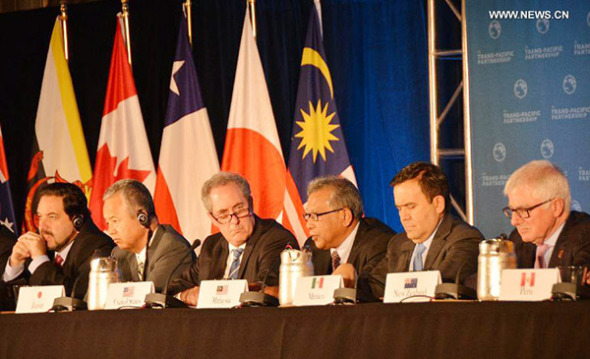
Trade ministers of the United States and 11 other Pacific Rim countries attend a press conference after negotiating the Trans-Pacific Partnership (TPP) trade agreement in Atlanta, the United States, on Oct. 5, 2015. Trade ministers of the United States and 11 other Pacific Rim countries "have successfully concluded" the Trans-Pacific Partnership (TPP) free trade talks, U.S. Trade Representative Michael Froman said Monday. (Photo/Xinhua)
The recent Trans-Pacific Partnership Agreement presents Asia with good, bad and ugly scenarios.
Had the TPP failed, that would have been a severe blow to the credibility of the United Sates in Asia. And yet, it excludes Asia's largest economies-China, Indonesia and India.
In Washington, the TPP has been praised as a triumph for the Obama administration. However, it still faces a tough battle with a divided Congress, amid presidential primaries, is now opposed by leading Democratic candidate Hillary Clinton-and needs the approval of 11 other TPP members' legislative bodies.
In China, the Ministry of Commerce said China welcomes the TPP agreement and hopes it can facilitate talks on other regional free trade deals to push economic growth in the Asia-Pacific region.
In 2005, the original TPP among Brunei, Chile, New Zealand and Singapore was a vision of an inclusive free trade agreement. Since 2010, Washington has led talks for an expanded, but more exclusive, "high-standard" FTA, which also includes the US and its trade allies Japan, Canada, Australia, and Mexico, plus Peru and Vietnam.
The negotiators hammered a deal with nations that represent very different levels of economic development. The living standards in the US are 10 times higher than those in Vietnam. As a result, talks were conducted under extraordinary secrecy, which left environmental movements, labor unions and cyber security observers angry.
The result is a preferential regional trade agreement dominated by the US dollar. Territorial and maritime friction in East and South China Seas has steadily accelerated in parallel with the US' pivot to Asia. The Pentagon is shifting the bulk of its naval assets to the region by 2020.
Understandably, Washington seeks to extend its current alliance arrangements in (non-China) East Asia to South and Southeast Asia. In Japan, the Upper House of the Diet passed Prime Minister Shinzo Abe's highly controversial security bills, which are opposed by most Japanese. But India has an independent international outlook. And the Association of Southeast Asian Nations seeks to hedge between declining US influence and China's rising clout.
The broader region is not choosing between China and the US, but each and both. Despite friction with China, the Philippines expressed interest in the TPP, but stayed out for economic reasons, as did Indonesia and Thailand. Myanmar, Laos and Cambodia are not economically ready for the TPP.
As for TPP signatories, Vietnam and Malaysia gain access to important US markets, while Singapore seeks greater access to the Americas, along with tiny oil-rich Brunei. Vietnam has had disputes with China, but all four enjoy economic cooperation with China, which remains one of their largest trade partners.
As members of the ASEAN-China FTA, all ASEAN member states benefit from economic cooperation with China. China also has bilateral FTAs with individual TPP members, including Singapore, Australia and New Zealand, Peru and Chile. Australia welcomed the TPP deal, but weeks after it had signed its FTA with China.
Beijing is also in talks to upgrade the FTA with ASEAN, negotiating a China-Japan-South Korea FTA and the broader Regional Comprehensive Economic Partnership. Following the Xi-Obama Summit, China and the US sped up work on the bilateral investment treaty.
China may join the TPP at a later point but only when it makes economic and strategic sense. As reforms deepen, Beijing can also gain similar or possibly greater benefits through an FTA of the Asia Pacific.
Where does it all leave Asia? As mentioned before, there are good, bad and ugly scenarios.
In the "containment déjà vu" scenario, the exclusive TPP contributes to the militarization of the Asia-Pacific, while economic benefits decrease. Instead of unity, fragmentation triggers friction. Economic growth dims. The "Asian Century" fails.
In the "much ado about nothing" scenario, the US Congress torpedoes the deal in the short term, or bilateral and multilateral trade deals in the region mitigate the TPP's discriminatory effects over time.
In the "inclusive free trade" scenario, the TPP serves as a foundation for a truly Asia-wide FTA; one that has room for China, the US, and 21st century currency arrangements. China and the US conclude a bilateral investment treaty. Growth accelerates and economic relations broaden across South, East and Southeast Asia.
Only the last scenario can sustain the promise of the Asian Century.


















































